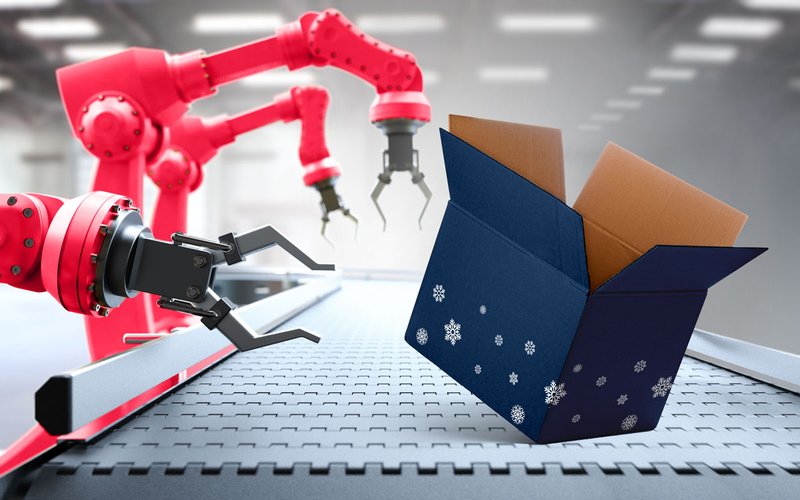
Santa’s digitalized warehouse
Automation key for ensuring presents are produced on time
With Christmas around the corner, it is time to focus on the world’s oldest warehouse — the one where Santa tirelessly packs millions of gifts. Things at Santa’s workshop have changed, the days of elves manufacturing toys using outdated devices are gone. Instead, Santa must invest in smart technologies to optimize production and distribution. Here Claudia Jarrett, US country manager at automation parts supplier EU Automation, advises Santa on how to implement technologies to automate his warehouse and keep up with the times.
Like many of us, Santa is familiar with the challenges of global supply chains — speed, traceability, and the necessity to accurately predict demand are just some of his headaches. There are roughly 2.2 billion children around the globe, which equals around 25 percent of the world’s population. If the average gift weighs 2.2lb, Santa must deliver 600 tons of presents in only one night.
Such a task requires solutions like collaborative robots and an Internet of Things (IoT) system to build a resilient supply chain for global distribution.
IoT tracking systems
To maintain an updated customer database and to keep track of orders, shipments, and inventory stock levels, Santa requires an incredible level of visibility across his supply chain. Thankfully, an Internet of Things (IoT) tracking system can help store and process data to vastly improve operations.
IoT asset tracking systems are vital for any distribution business as they reduce connectivity issues and ensure that every product is continuously monitored. Asset tracking provides IoT-based remote monitoring and management of assets by applying tracking devices, connectivity methods, and software. However, Santa is not the only one to have realized the potential of this technology — by 2027, around 267 billion asset tracking devices will be deployed globally, according to the Industrial IoT Asset Tracking report.
Connected sensors and machine-to-machine communication protocols help warehouse managers get real-time updates at every stage of the supply chain. They provide useful insights on asset locations, temperature, functionality and send the data reliably and continuously from anywhere in the world. Not only will Santa be informed in real-time about the location of each present but will also be able to track his sleigh’s fuel consumption and prevent any maintenance issues.
Collaborative robots
Supply chain management and efficient travel are just a couple of the festive activities Santa needs to worry about on the build-up to Christmas Eve. Another, and arguably the most important, is toy production. Instead of elves manufacturing toys using manual equipment, advanced tools — such as collaborative robots — can produce billions of presents in the same time frame.
Cobots are designed to optimize the workflow while allowing the warehouse to maintain its infrastructure design and processes. According to MarketsandMarkets, the collaborative robot is projected to grow from $1.2 billion in 2021 to reach $10.5 billion by 2027.
Some of the most innovative cobots are also very easy to program, even for workers with no knowledge of robot programming, as many of Santa’s older employees. Sometimes the process involves only physically moving the robot’s arm to the correct location. This further reduces initial automation costs and contributes to the return on investment (ROI), because there is no need to invest in training.
To demonstrate how automation can help with the festive season, Universal Robots employed two UR3e cobots to decorate a Christmas tree. These cobots are ideal for such a scenario, due to their lightweight of only 25lb, but also because of their 360-degree rotation ability on all wrist joints and infinite rotation on the end joint. ABB also used twelve robots to decorate retail spaces in New York for Christmas. Its famous dual-arm YuMi® cobot was used to serve coffee and interact with humans to create a unique merchandising experience.
The flexibility of cobots is just as useful in a warehouse context, and not just to serve coffee to hard-working elves. Cobots reduce the physical workload of warehouse employees, resulting in fewer injuries and increased job satisfaction. Cobots can also guide workers to maximize their productivity — for example, they can use artificial intelligence and advanced machine vision systems to plan the best picking routes, eliminating unnecessary walking.
Collaborative robots and IoT solutions are no doubt the future of automation, providing reliability and efficiency while reducing costs as well. Nevertheless, as with all technologies, they are prone to technical issues that need to be resolved in a timely manner to avoid downtime.
EU Automation provides new, refurbished, and obsolete parts for a large variety of automation manufacturers. And just like Santa, EU Automation quickly delivers all over the world. Whether they are based in the United States, Canada, or the North Pole, all warehouses need to invest in smart technologies to remain competitive and increase efficiency.
To find out more about the offerings for a smart warehouse at EU Automation, head to www.euautomation.com.
About EU Automation:
EU Automation stocks and sells new, used, refurbished, and obsolete industrial automation spares. Its global network of preferred partner warehouses, and wholly-owned distribution centers, enables it to offer a unique service within the automation industry, spanning the entire globe. It provides worldwide express delivery on all products meaning it can supply any part, to any destination, at very short notice.









